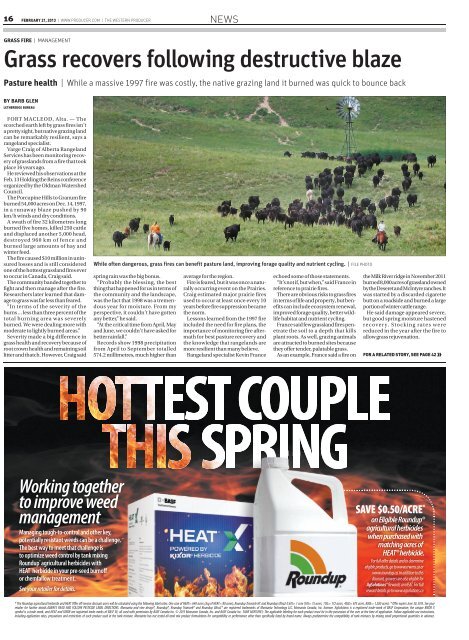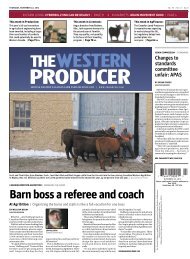16 FEBRUARY 21, 2013 | WWW.PRODUCER.COM | THE WESTERN PRODUCERNEWSGRASS FIRE | MANAGEMENTGrass recovers following destructive blazePasture health | While a massive 1997 fire was costly, the native grazing land it burned was quick to bounce backBY BARB GLENLETHBRIDGE BUREAUFORT MACLEOD, Alta. — <strong>The</strong>scorched earth left by grass fires isn’ta pretty sight, but native grazing landcan be remarkably resilient, says arangeland specialist.Varge Craig of Alberta RangelandServices has been monitoring recoveryof grasslands from a fire that tookplace 16 years ago.He reviewed his observations at theFeb. 13 Holding the Reins conferenceorganized by the Oldman WatershedCouncil.<strong>The</strong> Porcupine Hills to Granum fireburned 54,000 acres on Dec. 14, 1997,in a runaway blaze pushed by 90km/h winds and dry conditions.A swath of fire 32 kilometres longburned five homes, killed 250 cattleand displaced another 5,000 head,destroyed 960 km of fence andburned large amounts of hay andwinter feed.<strong>The</strong> fire caused $10 million in uninsuredlosses and is still consideredone of the hottest grassland fires everto occur in Canada, Craig said.<strong>The</strong> community banded together tofight and then manage after the fire.Researchers later learned that damageto grass was far less than feared.“In terms of the severity of theburns … less than three percent of thetotal burning area was severelyburned. We were dealing more withmoderate to lightly burned areas.”Severity made a big difference ingrass health and recovery because ofroot crown health and remaining soillitter and thatch. However, Craig saidWhile often dangerous, grass fires can benefit pasture land, improving forage quality and nutrient cycling. | FILE PHOTOspring rain was the big bonus.“Probably the blessing, the bestthing that happened for us in terms ofthe community and the landscape,was the fact that 1998 was a tremendousyear for moisture. From myperspective, it couldn’t have gottenany better,” he said.“At the critical time from April, Mayand June, we couldn’t have asked forbetter rainfall.”Records show 1998 precipitationfrom April to September totalled574.2 millimetres, much higher thanaverage for the region.Fire is feared, but it was once a naturallyoccurring event on the Prairies.Craig estimated major prairie firesused to occur at least once every 10years before fire suppression becamethe norm.Lessons learned from the 1997 fireincluded the need for fire plans, theimportance of monitoring fire aftermathfor best pasture recovery andthe knowledge that rangelands aremore resilient than many believe.Rangeland specialist Kevin Franceechoed some of those statements.“It’s not if, but when,” said France inreference to prairie fires.<strong>The</strong>re are obvious risks to grass firesin terms of life and property, but benefitscan include ecosystem renewal,improved forage quality, better wildlifehabitat and nutrient cycling.France said few grassland fires penetratethe soil to a depth that killsplant roots. As well, grazing animalsare attracted to burned sites becausethey offer tender, palatable grass.As an example, France said a fire onthe Milk River ridge in November 2011burned 8,000 acres of grassland ownedby the Deseret and McIntyre ranches. Itwas started by a discarded cigarettebutt on a roadside and burned a largeportion of winter cattle range.He said damage appeared severe,but good spring moisture hastenedrecovery. Stocking rates werereduced in the year after the fire toallow grass rejuvenation.FOR A RELATED STORY, SEE PAGE 42 »Working togetherto improve weedmanagementManaging tough-to-control and other key,potentially resistant weeds can be a challenge.<strong>The</strong> best way to meet that challenge isto optimize weed control by tank mixingRoundup ® agricultural herbicides withHEAT ® herbicide in your pre-seed burnoffor chemfallow treatment.See your retailer for details.SAVE $0.50 /ACRE *on Eligible Roundup®agricultural herbicideswhen purchased withmatching acres ofHEAT® herbicide.For full offer details and to determineeligible products, go to www.rrwms.ca orwww.roundup.ca. In addition to thisdiscount, growers are also eligible forAgSolutions® Rewards on HEAT. For fullreward details go to www.agsolutions.ca* <strong>The</strong> Roundup agricultural herbicide and HEAT Offer off-invoice discount acres will be calculated using the following label rates: One case of HEAT= 640 acres (Jug of HEAT= 80 acres), Roundup Transorb HC and Roundup Ultra2 0.67L= 1 acre (10L= 15 acres, 115L= 172 acres, 450L= 675 acres, 800L= 1,200 acres). * Offer expires June 30, 2013. See yourretailer for further details.ALWAYS READ AND FOLLOW PESTICIDE LABEL DIRECTIONS. Monsanto and vine design®, Roundup®, Roundup Transorb® and Roundup Ultra2® are registered trademarks of Monsanto Technology LLC, Monsanto Canada, Inc. licensee. AgSolutions is a registered trade-mark of BASF Corporation; the unique KIXOR Xsymbol is a trade-mark, and HEAT and KIXOR are registered trade-marks of BASF SE; all used with permission by BASF Canada Inc. © 2013 Monsanto Canada, Inc. and BASF Canada Inc. TANK MIXTURES: <strong>The</strong> applicable labeling for each product must be in the possession of the user at the time of application. Follow applicable use instructions,including application rates, precautions and restrictions of each product used in the tank mixture. Monsanto has not tested all tank mix product formulations for compatibility or performance other than specifically listed by brand name. Always predetermine the compatibility of tank mixtures by mixing small proportional quantities in advance.
NEWSTHE WESTERN PRODUCER | WWW.PRODUCER.COM | FEBRUARY 21, 2013 17RESEARCH | CANOLACanola in rotation proves promisingSoybeans are gaining interest as new shorter season varieties aredeveloped. | FILE PHOTORESEARCH | SOYBEANSSask. soybean trialresults exciting,but still pose riskConditions ideal | Researcher says yields werepromising last year, but frost is still a threatMELVILLE, Sask. — AgricultureCanada researchers did somethingunusual last year. <strong>The</strong>y seeded aparcel of land to canola for the firsttime.<strong>The</strong> land near Indian Head, Sask.,had been used for a field pea rotationstudy for the previous 17 years,growing rotations of continuouspeas, wheat-peas or wheat-wheatpeas,researcher Guy Lafond toldproducers at a recent Indian HeadAgricultural Research FoundationSeminar in Melville.<strong>The</strong> research centre started a newproject last year, scrapping the pearotations and adding canola into themix.Pea fields are susceptible to sclerotinia,but the old rotations didn’tappear to influence the performanceof last year’s canola crop.<strong>The</strong> resulting numbers are encouraging.Plant density was similar acrossall three sites — 65 to 73 plants persq. metre — as were yields, whichfell to slightly less than 35 bushelsper acre.“Even though we had a continuouspea rotation for all of these years… it did not exacerbate the problemsin terms of diseases in canola,”Lafond told producers.<strong>The</strong> plot will be seeded to wheat inthe upcoming crop year and thencanola the following year.“If you do include pulse crops inyour rotation, you shouldn’t beFirst year trials showed swapping peas for canola in rotationsproduced no increase in diseases. | FILE PHOTOconcerned about losing yield (incanola)” said Lafond.Other Agriculture Canada researchhas also showed a rotationwith peas outperforming others indry years, he added.Lafond encouraged producers toweigh the long-term risks of shortenedcanola rotations when makingcropping decisions, as well as thethreat of sclerotinia and blackleg.He said last year’s results shouldn’tdiscourage producers from includingfield peas in their rotations.puts nutrients where they count.STORIES BY DAN YATESSASKATOON NEWSROOMMELVILLE, Sask. — <strong>The</strong> same conditionsthat encouraged the spread ofsclerotinia in Saskatchewan canolacrops last summer actually provideda boost to a small set of soybean trialsin the province, says the researchmanager of the Indian Head AgriculturalResearch Foundation.However, while one year of soybeantrial data are encouraging, Chris Holzapfelstill believes it’s a risky crop togrow in southeastern Saskatchewan.“I don’t know if we can expect to dobetter than this in our environment,but this was certainly exciting to me,”he told producers at a recent seminarin Melville.Lots of heat and then a shot of moisturein late July boosted yields past 40bushels per acre for some varietiesfrom Manitoba’s NorthStar Genetics,which the organization began testinglast summer.Results from commercial growersin the area varied from 20 bu. per acreto the higher numbers, he added.Holzapfel said improved genetics,which are better suited to a shorterseason and cooler temperatures, aswell as the crop’s success in Manitobaare driving interest from growers.NorthStar’s earliest maturing variety,Reston, is pegged at 109 days andIt should still be considered, inmy opinion, a fairly risky crop. Iwouldn’t seed the whole farm tosoybeans at this time.CHRIS HOLZAPFELINDIAN HEAD AGRICULTURALRESEARCH FOUNDATIONwas one of the standout performersof the handful tested.Plants are mature when 95 percentof pods have changed colour. Someof the company’s other varieties arelisted with days to maturity up to 114days.“(So it’s) still a fairly long seasoncrop relative to our wheat and canolaand barley, things like that,” he said.“But it has been achievable for thelast couple of years.”Researchers in Indian Head seededthe soybeans at 200,000 seeds peracre into spring wheat stubble.While the results are encouraging,the risk of an early frost in late Augustor early September remains a significantthreat to the crop.“It should still be considered, in myopinion, a fairly risky crop,” saidHolzapfel.“I wouldn’t seed the whole farm tosoybeans at this time.”REAL Results!“We’ve used Awaken ST on our wheat for the past two years. We heardgood things about it, so we put it in side-by-side trials on our farm. Wesaw an increase in yield by four bushels per acre with Awaken ST. Itdefinitely paid for itself in a hurry.“We also noticed quicker emergence and the plant count was significantlyhigher in our wheat treated with Awaken ST than without. <strong>The</strong>re wereabout three or four more plants per square foot.“Awaken ST is a good product. It definitely helps. Foranyone who hasn’t used it before, I would recommendtrying a couple jugs. Put it on a few acres and see theresults for yourself. Especially if the season is cold andconditions aren’t ideal for germination. Awaken willgive your crop the extra boost it needs and you willsee a huge increase.“We will definitely be using Awaken STagain next year.”1-800-561-5444 www.uap.caAlways read and follow all label directions. Awaken is a registeredtrademark of Loveland Products Inc. UAP Canada is a member ofCropLife Canada. 01.13 13003Gregoire Seed Farms Ltd.Rory GregoireNorth Battleford, SK
- Page 1 and 2: THURSDAY, FEBRUARY 21, 2013 VOL. 91
- Page 3 and 4: NEWS THE WESTERN PRODUCER | WWW.PRO
- Page 5 and 6: NEWS THE WESTERN PRODUCER | WWW.PRO
- Page 7 and 8: MARKETS THE WESTERN PRODUCER | WWW.
- Page 9 and 10: MARKETS THE WESTERN PRODUCER | WWW.
- Page 11 and 12: THE WESTERN PRODUCER | WWW.PRODUCER
- Page 13 and 14: OPINION THE WESTERN PRODUCER | WWW.
- Page 15: NEWS THE WESTERN PRODUCER | WWW.PRO
- Page 19 and 20: NEWSTHE WESTERN PRODUCER | WWW.PROD
- Page 21 and 22: THE WESTERN PRODUCER | WWW.PRODUCER
- Page 23 and 24: FARM LIVINGTHE WESTERN PRODUCER | W
- Page 25 and 26: FARM LIVINGTHE WESTERN PRODUCER | W
- Page 27 and 28: THE WESTERN PRODUCER | WWW.PRODUCER
- Page 29 and 30: NEWSTHE WESTERN PRODUCER | WWW.PROD
- Page 31 and 32: NEWSTHE WESTERN PRODUCER | WWW.PROD
- Page 33 and 34: RESEARCH | PHOTOSYNTHESISBY MARY MA
- Page 35 and 36: NEWSTHE WESTERN PRODUCER | WWW.PROD
- Page 37 and 38: NEWSTHE WESTERN PRODUCER | WWW.PROD
- Page 39 and 40: THE WESTERN PRODUCER | WWW.PRODUCER
- Page 41 and 42: THE WESTERN PRODUCER | WWW.PRODUCER
- Page 43 and 44: NEWSTHE WESTERN PRODUCER | WWW.PROD
- Page 45 and 46: NEWSTHE WESTERN PRODUCER | WWW.PROD
- Page 47 and 48: NEWSTHE WESTERN PRODUCER | WWW.PROD
- Page 49 and 50: THE WESTERN PRODUCER | WWW.PRODUCER
- Page 51 and 52: THE WESTERN PRODUCER | WWW.PRODUCER
- Page 53 and 54: THE WESTERN PRODUCER, THURSDAY, FEB
- Page 55 and 56: THE WESTERN PRODUCER, THURSDAY, FEB
- Page 57 and 58: THE WESTERN PRODUCER, THURSDAY, FEB
- Page 59 and 60: THE WESTERN PRODUCER, THURSDAY, FEB
- Page 61 and 62: THE WESTERN PRODUCER, THURSDAY, FEB
- Page 63 and 64: THE WESTERN PRODUCER, THURSDAY, FEB
- Page 65 and 66: THE WESTERN PRODUCER | WWW.PRODUCER
- Page 67 and 68:
AstroOVER400CAR & TRUCK SALES LTD.
- Page 69 and 70:
HUGEBLOWOUT!SAVE BIG!2011 FORD F150
- Page 71 and 72:
THE WESTERN PRODUCER, THURSDAY, FEB
- Page 73 and 74:
THE WESTERN PRODUCER, THURSDAY, FEB
- Page 75 and 76:
THE WESTERN PRODUCER, THURSDAY, FEB
- Page 77 and 78:
THE WESTERN PRODUCER, THURSDAY, FEB
- Page 79 and 80:
THE WESTERN PRODUCER, THURSDAY, FEB
- Page 81 and 82:
THE WESTERN PRODUCER, THURSDAY, FEB
- Page 83 and 84:
THE WESTERN PRODUCER, THURSDAY, FEB
- Page 85 and 86:
NEWSTHE WESTERN PRODUCER | WWW.PROD
- Page 87 and 88:
THE WESTERN PRODUCER | WWW.PRODUCER
- Page 89 and 90:
PRODUCTIONTHE WESTERN PRODUCER | WW
- Page 91 and 92:
PRODUCTIONTHE WESTERN PRODUCER | WW
- Page 93 and 94:
NEWSTHE WESTERN PRODUCER | WWW.PROD
- Page 95 and 96:
THE WESTERN PRODUCER | WWW.PRODUCER
- Page 97 and 98:
LIVESTOCKTHE WESTERN PRODUCER | WWW
- Page 99 and 100:
LIVESTOCKTHE WESTERN PRODUCER | WWW
- Page 101 and 102:
AGFINANCETHE WESTERN PRODUCER | WWW
- Page 103 and 104:
WEATHERTHE WESTERN PRODUCER | WWW.P








